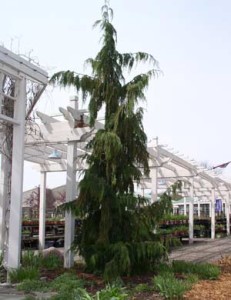False-Cypress – Pruning, Winter Care and Fertilizing
 This genus falls into to categories
This genus falls into to categories
Alaskan Weeping False Cypress: This medium side evergreen needs little pruning, but it’s winter structure structure is important. So crossing or poorly formed branches can be removed to promote a more regular weeping structure. If a central leader is lost a new one can be established by tying a side shoot in an upright position for 18 months.
Upright and rounded Fales Cypress:These evergreens can be sheared lightly in early spring to improve the plants shape and increase density. The plant should be wider at the base than the top, to allow light to reach the lower branches. “Pick pruning” will extend the useful life of the plant by giving it a deeper “green” zone. This is done by cutting small holes in the surface of the plant, allowing more light in and new buds to form on the inside of the plant.
Newly planted evergreens respond very well to fertilizing. Either granular, liquid or stake type fertilizers can be used. Granular fertilizers can be worked into the soil around the plant at a rate of 2 lbs or 2 pints per 100 square feet of planting bed. An alternative way to apply granular fertilizers starts with drilling or punching 6” deep holes at the drip line of the tree. Poured into these holes should be a total of 2 pounds of fertilizer per 1″ of trunk diameter (divided up and poured evenly between all of the holes). These holes should not be filled with more than 1/3 of the fertilizer and then they should be top filled with soil. This method of fertilization should only be done once a year, and is best done in late fall after leaf drop, or in early spring before bud break. Multi Purpose 10-10-10 Fertilizer by Greenview works well.
Liquid fertilizers (such as Miracle Gro) are mixed with water and applied the same as you would water the plant (see product for specific details). This should be done three or four times per year starting in late April and ending in mid July. Stake type fertilizers can be used following the directions on the package. With any of the above techniques, a higher nitrogen mix should be used; 20-20-20 or similar mix is a good choices. Organic fertilizers, like manure, can also be used with good results. The material should be worked into open soil at a rate of one bushel per 1″ of trunk caliper or 100 square feet of bed area. As evergreens mature, less fertilizing or lower nitrogen mixes should be used. These plant need little winter care, but should be checked occasionally for rabbit or other damage. If rabbit damage is found, you can protect the plant with a fence formed with hardware cloth (looks like chicken wire but with small square holes). To do this, the base of the plant should be tied up and a circle of hardware cloth can be placed around the outside. The base of the hardware cloth should be buried in the soil or mulch. This protection should be installed in late November and removed in mid April.
These evergreens will perform well through most winters. In severe winters, however, they may discolor, but will bounce back in spring. Winter protection may be needed, however, for the first few years after installation, or if the plant has been under stress. The plant can be protected by wrapping it in burlap, or enclosing it in a burlap tent. This form of protection will keep the wind and sun off, but will not cut off air flow or trap heat, which can be harmful to the plant. A burlap tent is made by setting three wooden stakes into the ground around the plant and stapling burlap to it on all three sides. The top of this tee-pee like structure should be left open. If the plant is in open soil it should be mulched and get a good watering in early November if the soil is dry. Watering in late fall is very important for the winter health of any evergreen and should be done to young plants every year in early November. Even more mature plants can benefit from late season waterings, especially after a dry fall season.
